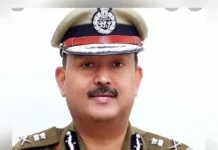[ Prof Tomo Riba ]
The foundation stone of the present Rajiv Gandhi University (RGU), which was laid by the then prime minister Indira Gandhi on 4 February, 1984, in the presence of the then chief minister Gegong Apang and Prem Khandu Thungon, still bears testimony to the fact that the original name of the present RGU was Arunachal University, which had a complete address in itself.
It took four years to set up basic infrastructure in Rono Hills. Before shifting to the present campus, the BEd class was conducted in Itanagar, in a barrack building meant for a night college, near the present government higher secondary school, Itanagar. Answer scripts were sent to Chandigarh for evaluation. The departments of history and political science were established in Pasighat. After the purchase of the present campus from four villages, a few basic structures were developed, and in 1988-99, those three departments were shifted to Rono Hills. Prof CL Anand was the first vice chancellor of the university.
During those days, life in the campus was completely different. It was a paradise for deputed teachers for BEd course. Though hunting and fishing were out of syllabus, they were given maximum time. Along with pens, a few deputed teachers had also brought guns with them. Animals like barking deer, monkeys, civets and wild fowl were hunted. Dried skins of deer with hair were presented to teachers as decoration items.
To reach the campus was very much arduous. Commuter employees from Itanagar and Naharlagun had to make big round via Harmuty, with an extra distance of around 30 kms. There was also a boat to ferry people across the Dikrong river, which was perilous during Monsoon. Sometimes the current of the water was much stronger than the arms of the boatmen, and boats were carried away further down the stream with wailing passengers in it.
Then came a hanging bridge across the river in 1994, which tested the people’s driving skills in the swing bridge on metal wire. The middle portion of the bridge was raised; so we could not see rickshaws coming from both the ends. Sometimes, two or many rickshaws used to meet in the centre of the bridge. Rickshaws with weaker passenger had to retreat, which made it a tough job to push back the rickshaws on the narrow bridge.
The coming up of the hanging bridge encouraged many to buy scooters – either a Bajaj Super or a Bajaj Chetak. The university had a white ambassador for the VC and a 407 mini-bus. Later on, a white Gypsy and a dark-green van were purchased for the registrar and the CoE.
We were proud to have those four vehicles. Now, RGU has more than 10 buses, a truck, and tankers for lifting water, two ambulances and a good number of small official vehicles. Pre-primary school was run in a Type V quarters.
In the beginning (1990s), elephants outnumbered the campus dwellers. Elephants opposed the construction of the present secondary school. During construction time, elephants would come at night and damage the day’s work. One night, an elephant sneaked into the store of the school and ate up the whole newly-collected chalks.
During daytime, students and employees used to play in the present playground, and at night elephants used it. We remained confined to the southern tip of the campus and maximum part of the present campus was occupied by elephants. The present Subansiri Halls of Residence was enough to accommodate all the students. The present old auditorium was sufficient to accommodate all the students of the university during examinations.
Today, RGU has 12 hostels, but only 50 percent students can be accommodated. Changes were very slow in the beginning, but it picked its momentum; many changes have come in the university.
In 1995, the first computer came. It was a very costly and rare item for us. Very few were allowed to touch it. For its safety, especially from viruses, a special room was created. Use of shoes and even loud talks were not allowed in the room where the computer was kept. To get a page printed, we had to wait for a few minutes, silently watching the printer, its head running left and right, paper moving from the trey sluggishly. There used to be silence, except the sound of the head and the roller of the printer, as if it was counting every word. Today, e-waste has become another problem for RGU.
During 2004-2006, there was a movement initiated by the Arunachal University Teachers’ Association (AUTA) for conversion to central university, where Prof Tana Showren played a great role in influencing the favour of Rajya Sabha member Nabam Rebia, who was also the general secretary of the MP Forum of North East Region. He got the signatures of all the MPs of the Northeast region in favour of conversion of the state university into a central university. When almost all the processes were over, and the Centre in its national policy decided to create one central university in all the states of the Northeast region; the name of Arunachal University was changed to Rajiv Gandhi University. That made us feel a sense of loss of identity, and we protested. Our protests were never heard. Finally, RGU was converted into a central university on 9 April, 2007, with continued use of the old logo.
On this day of its 37th foundation day, let us remember the contributions of formers vice chancellors like Prof CL Anand, Madan Jha, Raghunathan, Prof AC Bagabati, Dr KK Dwivedi, Prof SC Jha, Prof KC Belliappa, Prof Atul Sarma, Prof David R Syiemlieh and Prof Tamo Mibang.
Prof Tamo Mibang was the longest serving VC of the university. RGU is fortunate to have Prof Saket Kushwaha as the present vice chancellor of the university. At present, most of the activities of central universities are directly controlled from Delhi. In such a situation, the university needs a leader who has a warm connection with the education ministry and the UGC.
Dr Joram Begi and Dr Tai Nyori also contributed much in making this university. Dr Begi served this university as a registrar for 10 years. Dr Tai Nyori served this university as controller of examinations for 17 years, and as a registrar for six years.
RGU, the easternmost located central university, has left behind many central universities in the race of academic achievement. It has bagged the second rank in the country among the universities as per rating of the UGC and the union education ministry.
Based on the performance of the universities during the Corona pandemic period, RGU has been rated the best university among the Himalayan universities.
Today, RGU runs more than 95 programmes, including PG programmes, undergraduate courses, diploma courses, certificate courses, including PhD and MPhil. Under RGU, there are 43 affiliated colleges, both government and private.
The following are the few uniqueness of RGU. The Arunachal Institute of Tribal Studies is actively devoted to documentation and publication of tribal culture. The department of zoology has identified many new fish species of Arunachal Pradesh. Most of the major traditional festivals of the state along with the festivals of the country are celebrated in the campus by the students and employees. University Festival, University Panorama and Inter-College Youth Festival are organized, where along with the games and sports, the culture of the tribes are displayed, including house pattern, traditional attires and traditional foods, folk songs, and dances.
The good practices of RGU are: convocation, admission, examination, and declaration of examination results according to calendar. Another uniqueness of RGU is that the university has a campus life. One would find most of the teachers, students and non-teaching employees staying in the campus. Unlike other academic institution, there is no campus politics.
With this positive mind-frame and hard work, RGU would move further towards academic excellence. Though RGU is a central university, the state government of Arunachal Pradesh has also contributed much in developing the university in the form of providing proper road connectivity, water supply, power and few prominent buildings. (The contributor is HoD, Geography, RGU)





